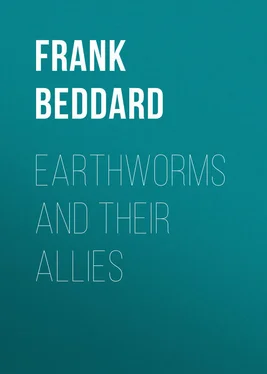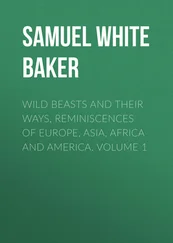Frank Beddard - Earthworms and Their Allies
Здесь есть возможность читать онлайн «Frank Beddard - Earthworms and Their Allies» — ознакомительный отрывок электронной книги совершенно бесплатно, а после прочтения отрывка купить полную версию. В некоторых случаях можно слушать аудио, скачать через торрент в формате fb2 и присутствует краткое содержание. Жанр: foreign_antique, foreign_prose, на английском языке. Описание произведения, (предисловие) а так же отзывы посетителей доступны на портале библиотеки ЛибКат.
- Название:Earthworms and Their Allies
- Автор:
- Жанр:
- Год:неизвестен
- ISBN:нет данных
- Рейтинг книги:3 / 5. Голосов: 1
-
Избранное:Добавить в избранное
- Отзывы:
-
Ваша оценка:
- 60
- 1
- 2
- 3
- 4
- 5
Earthworms and Their Allies: краткое содержание, описание и аннотация
Предлагаем к чтению аннотацию, описание, краткое содержание или предисловие (зависит от того, что написал сам автор книги «Earthworms and Their Allies»). Если вы не нашли необходимую информацию о книге — напишите в комментариях, мы постараемся отыскать её.
Earthworms and Their Allies — читать онлайн ознакомительный отрывок
Ниже представлен текст книги, разбитый по страницам. Система сохранения места последней прочитанной страницы, позволяет с удобством читать онлайн бесплатно книгу «Earthworms and Their Allies», без необходимости каждый раз заново искать на чём Вы остановились. Поставьте закладку, и сможете в любой момент перейти на страницу, на которой закончили чтение.
Интервал:
Закладка:
It would seem to be quite possible that when the fresh waters of the world have been as well examined for Oligochaeta as have so many parts of the land areas, the number of purely aquatic Oligochaeta will be found to equal those inhabiting the land. In any case we are quite justified at the present moment in stating that there are rather more families of these smaller Oligochaeta than there are of the bulkier terrestrial forms. But while there are certainly seven or eight distinct families, these do not between them contain at present so many genera as do the fewer families of earthworms; and the number of species of the latter that are known to science enormously exceeds that of the 'Limicolae' as the fresh-water worms were at one time called in common. The fact that there are purely marine forms of these water worms was hardly appreciated at the time that the term Limicolae was used; now however we are acquainted with a few such forms, and even with some which live at will in either fresh, salt, or brackish water. Of these something will be said later.
These forms have also been collectively treated of as Microdrili, a term which expresses the undoubted fact that they are all of small size and sometimes even minute; others however reach the dimensions of the smaller species of earthworms. There are a certain number of characters shared by the various families which may be considered first of all, before dividing them into their several subdivisions. These aquatic Oligochaetes are usually tender and transparent, the muscular layers of the body wall being much reduced as compared with the tougher terrestrial forms. The clitellum is also thinner and consists of a single layer of cells only, thus contrasting with the double layered clitellum of earthworms. As a rule the alimentary tract is simplified, there being no gizzard or glandular appendices of the oesophagus comparable to the calciferous glands of most earthworms. But this rule is not without exceptions; for we find in Haplotaxis a gizzard occasionally developed, and in the remarkable genus Agriodrilus from the Baikal lake a continuous gizzard formation along the oesophagus, while the Enchytraeidae may show something very like calciferous glands: and even a Tubificid, called by Pierantoni Limnodriloides , has a pair of diverticula of the gut.
Other internal organs show certain points of likeness in all or in the great majority of the aquatic families. Thus the nephridia are without a plexus of blood capillaries surrounding them, a state of affairs which also occurs in some of the slender Ocnerodrilinae among the earthworms. These paired organs also are very frequently not found in the anterior segments of the body and these include also as a general rule the segments in which the reproductive elements are formed. Save for an exceptional case among the genera of Enchytraeidae the dorsal pores are not found among the Limicolae, but in some cases at least a single pore, the head pore, is found. The sperm ducts, which among earthworms usually (and indeed always save in the anomalous Moniligastridae) traverse a considerable number of segments on their way from the internal opening into the body-cavity to the external pore, do not show the same phenomenon among the Limicolous Oligochaeta. They are sometimes indeed limited to a single segment, that is to say the funnels and the external pore lie in one segment. In other cases they open on to the exterior in the segment next to that which bears the funnel, and it is only rarely that they traverse more than one segment. There are also points of difference of general applicability to be noted in the sperm sacs and egg sacs. The latter are large and extensive, which is not the case among earthworms, and the former are as a rule more extensive in the number of segments that they occupy than among the terrestrial forms. Another difference which they show is that their cavity is quite simple and not divided up by trabeculae into numerous intercommunicating chambers as in the earthworms. Finally the eggs of the aquatic Oligochaeta are large and full of yolk and thus contrast with the very small ova of the earthworms which are moreover much more abundant. These features are either of general or universal occurrence and together form an assemblage of characters which mark out the aquatic families of Oligochaeta from their, at least mainly, terrestrial allies.
We may also refer to certain structures which although not universal among these aquatic families are nevertheless found only in them – that is, are not found in any family of the terrestrial worms of this order. The most salient of such characters are the long and hair-shaped setae tapering to a fine point and often provided with a series of delicate branches like a feather; such setae are often of very great length and they occur in their various modifications among the Aeolosomatidae, Naididae, and Tubificidae. It is clear that these delicate setae, though they may not be due in any way to the aquatic life, are rendered possible by it. To drag such tender processes through stiff clay would surely break and tear them out. It may be also mentioned that among the aquatic families as a rule the intersegmental septa do not show that thickening in some of the anterior segments of the body which is so general a feature of the land-dwelling species. Finally it is only among the aquatic forms, and among them only in the families Aeolosomatidae and Naididae, that asexual reproduction by budding takes place. Indeed so common and usual is it in the genera of these families that even yet there are considerable lacunae in our knowledge of the organs of reproduction in the said families.
Together with these general similarities are many points of structural difference among the worms inhabiting ponds, lakes, and rivers, which allow of their being divided into a number of quite distinct families.
One of the most distinct of these families and lying in any case quite at the base of the series is the family Aeolosomatidae which includes a number of distinct species of delicate and transparent worms, and in whose integument are embedded round cells bearing a large brightly coloured oil drop; this is reddish or green in colour, or – and this more rarely – colourless, but still recognisable as an oil drop. The green sometimes even verges upon blue on the one side and yellow on the other, while the red may approach brown or purple. These worms are assigned for the most part to the genus Aeolosoma which is found in all of the great continents and of which seven or eight species are known. To a more doubtful genus Pleurophleps are assigned a few small worms which have the general appearance of Aeolosoma , but are without the coloured or colourless oil drops in the skin. These worms have a very large prostomium which is ciliated on the lower surface, and the body is not markedly segmented externally by constrictions or internally by septa. The bristles are slender and hair-like, but among them are in some species the shorter stouter bristles bifid at the free tip, which are so general among the aquatic families of the Oligochaeta. These worms are not uncommon objects in pools containing weed; and they are to be found usually crawling among the weed. They consist as a rule of but few segments to most of which a pair of nephridia belong. The ovaries and the spermaries are only known in a few forms and appear to be unpaired and lie respectively in the fifth and sixth segments. There are 1-3 pairs of spermathecae, and the sperm ducts if distinct from, are at least very like, nephridia. The ova appear to make their way to the exterior by a large aperture in the ventral middle line of a middle segment of the body. The vascular system contains uncoloured blood and is greatly simplified.
The next family to the Aeolosomatidae in zoological position is clearly the Naididae. These are also small worms, but show in some respects a higher grade of organisation than their allies. While asexual generation is general, the reproductive organs are more commonly found than in Aeolosoma , though there are still many hiatus in our knowledge of the same in certain genera. Where they are known it has been found that the spermaries and ovaries are very far forward in the body, in the fifth and sixth segments respectively. The spermathecae are in segment six and the male ducts open into a terminal chamber, called 'atrium,' which is on the whole not unlike that of the Tubificidae. The blood in these worms is red as in the higher types, and thus differs from that of the genus Aeolosoma . The setae are rather varied, being in some cases long and slender, sometimes greatly exaggerated in length as in Ripistes ; other setae are forked at the free end, and in Paranais this is the only kind of setae met with. A marked feature of this family is that the dorsal bundles of setae do not always begin like the ventral setae upon the second segment of the body. Indeed in Schmardaella there are no bundles of dorsal setae at all. The Indian genus Branchiodrilus is remarkable for the fact that it has paired processes of the body which may be termed gills and which in some segments involve the dorsal setae. Another kind of gill is found in the genus Dero (which has many species) and in the allied Aulophorus . These are placed round the vent, and are ciliated. Other genera are Nais , Chaetogaster , Vejdovskyella , Amphichaeta , Stylaria , Macrochaetina , Pristina , Naidium .
Читать дальшеИнтервал:
Закладка:
Похожие книги на «Earthworms and Their Allies»
Представляем Вашему вниманию похожие книги на «Earthworms and Their Allies» списком для выбора. Мы отобрали схожую по названию и смыслу литературу в надежде предоставить читателям больше вариантов отыскать новые, интересные, ещё непрочитанные произведения.
Обсуждение, отзывы о книге «Earthworms and Their Allies» и просто собственные мнения читателей. Оставьте ваши комментарии, напишите, что Вы думаете о произведении, его смысле или главных героях. Укажите что конкретно понравилось, а что нет, и почему Вы так считаете.












